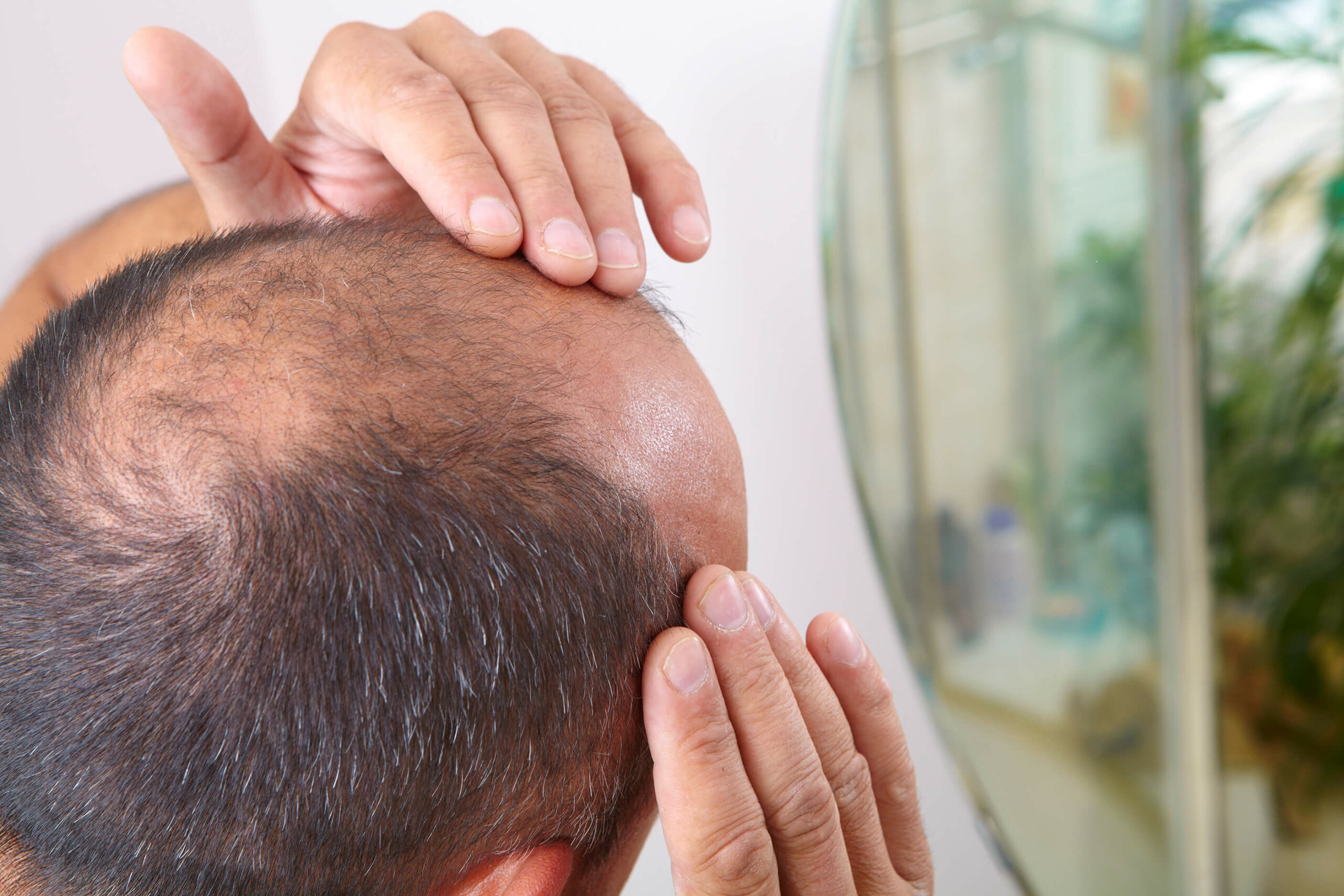If the day should arrive when you think you’re experiencing hair loss, you might feel worried and uncertain. The good news is that some amount of hair loss is normal. Male pattern baldness, on the other hand, isn’t — but this type of hair loss is perfectly treatable. In this article, we’ll explain the science behind this type of hair loss, and show you exactly what ends up happening to your hair.
Everyone loses hair… in moderation
People lose hair every day. Moderate hair loss is a normal part of life. Some of your hairs have to fall out so that your hair follicles can produce new hair strands.
A study published in the Dermatologic Clinics journal reported that people tend to lose 50-150 every single day. But don’t worry, the average human has around 100,000 hairs on their head, so this amount of hair loss isn’t a big deal.
Just like the water cycle and life cycle, hair has its own cycle, too. A study published in the journal Differentiation reported that healthy hair goes through a balance of growth phases, regression phases, and rest phases.
If you’re experiencing hair loss, it means your hair’s growth cycle has encountered a problem. People with hair loss tend to lose far more than 150 hairs each day. Depending on the type of hair loss you’re experiencing, you might start seeing sudden, extreme hair shedding or just feel like your hair is growing unusually slowly.
What is male pattern hair loss?
Male pattern baldness, also known as androgenic alopecia, is the most common cause of hair loss in men. This condition is caused by a mixture of genetic and hormonal factors. According to the U.S. National Library of Medicine, more than 50 million men in the USA are affected by male pattern hair loss.
If left untreated, androgenic alopecia will lead to baldness. A study in the Journal of Cutaneous and Aesthetic Surgery says that this condition presents as thinning hair, shrinking hair follicles, and loss of hair on specific parts of your head.
Despite the name, male pattern baldness doesn’t cause rapid hair loss. In fact, this is actually a gradual loss of hair that occurs over many years. Most people don’t realize they have androgenic alopecia until their hair loss has progressed to a certain point.
Stages of male pattern hair loss
When you first start experiencing hair loss, you might only notice subtle changes. You might notice your forehead looking larger, or feel like you’re seeing changes to your hairline.

An uneven or shifting hairline is one of the first signs of androgenic alopecia.
As hair loss progresses, it becomes more noticeable. You’ll likely start to experience thinning at the top of your head, which is also known as the crown.

Hair loss at the crown can go unnoticed for quite a while, given its position on your head.
As time passes, those hairline changes will start to become increasingly obvious, particularly around your temples. The U.S. National Library of Medicine says you’ll eventually see your hairline move into an ‘M’ shape.

Hairline changes eventually progress into distinct areas of hair loss around the temples.
Eventually, androgenic alopecia causes you to lose that ‘M’ shape too, because that peak of hair closest to your forehead also starts to get thinner and fall out.

The ‘M’ shape androgenic alopecia causes is short-lived, as this hair eventually falls out, too.
Simultaneously, the hair at the crown of your head continues getting thinner. Eventually, you’ll only have a thin strip of thick hair separating these two main areas of hair loss.

As hair loss progresses, it’s common to have thick strips of hair surrounded by larger thinning patches.
Most people won’t lose all of this hair all at once. You’ll likely end up with a fine distribution of hair from your hairline to the crown of your head. This hair will also disappear over time.

Late-stage androgenic alopecia leaves a sparse amount of thinning hair across the top of the scalp.
Eventually, you’ll go bald – though this tends to happen quite a few years down the line. However, this doesn’t mean losing all of the hair on your head. Androgenic alopecia only induces the loss of hair along the top of your head, from your temples to your crown.

Androgenic alopecia doesn’t affect the hair along the lower sides or back of your head.
This means that you’ll never lose the hair on the lower sides or back of your head. If you’re not a fan of this look, you’ll need to either have a hair transplant or shave it regularly. You could also consider a cosmetic hair loss treatment like scalp micropigmentation.
Androgenic alopecia treatment options
As the most common cause of baldness, androgenic alopecia also has the most treatment options. Regardless of the stage of hair loss you’re experiencing, talk to your doctor: you can almost certainly find a hair loss treatment that will work for you.
FDA-approved treatments
Minoxidil
This topical treatment can prevent further hair loss and encourage new hair growth. It’s available as a foam and serum and is applied directly onto the area where you’d like to see more hair. Minoxidil is particularly good for mild to moderate hair loss.
Finasteride
This pill treats hair loss by blocking the body’s production of DHT (dihydrotestosterone), an androgen associated with male pattern baldness. There are currently topical versions of this treatment being researched.
Low-level laser therapy (LLLT)
This works with your hair follicles on a cellular level in a different way. In order to obtain this treatment you’ll have to go into a clinic that offers it or obtain your own device. Although LLLT has excellent results, it’s more expensive than minoxidil or finasteride.
Surgical treatments
If your hair loss has progressed past a certain extent, your doctor might recommend for you to get a hair transplant like Follicular Unit Extraction (FUE) or Follicular Unit Transplantation (FUT). Essentially, hair follicles are transplanted from the back or sides of your head into the areas where you have lost hair. This essentially gives you new hair follicles around your crown, temples, and hairline that aren’t affected by androgenic alopecia.
Alternative and experimental treatments
At the moment, minoxidil, finasteride, and low-level laser therapy are the only FDA-approved treatments for androgenic alopecia. However, there are a wide variety of experimental treatments currently being researched.
For example, according to a review in the International Journal of Molecular Sciences, regenerative medicine treatments like microneedling and platelet-rich plasma therapy have both shown promise in treating male pattern baldness. Another review, from the Journal of Drugs and Dermatology, reported the effectiveness of topical finasteride and dutasteride. Given their excellent results, it’s likely the FDA will approve these as treatments for androgenic alopecia in the near future.
Considerations when choosing a treatment
Regardless of the treatment, you won’t be able to resolve your hair problems overnight. A study from the Biomedical Dermatology journal found that people taking minoxidil waited between 2 and 4 months before noticing any change in their patterned hair loss.
Most hair loss treatments are for the long haul. In order for treatments like minoxidil or finasteride to work, you’ll need to take them continuously. Keep in mind that surgical treatments, which produce more immediate results, are often combined with treatment options like minoxidil to maximize their effectiveness.
Other causes of hair loss
If you’re seeing hair loss but it doesn’t look like patterned hair loss, it’s possible that you might not have androgenic alopecia. For example, round, patchy hair loss is indicative of an autoimmune condition called alopecia areata. This type of hair loss can also occur around other parts of your body — not just your head.
However, it’s much more likely that you’re experiencing telogen effluvium – a common type of diffuse hair loss. This condition often occurs after you experience severe stress, but might also occur if you have a chronic illness, have recently been sick, or started a new medication. According to the Indian Journal of Dermatology, Venereology, and Leprology, telogen effluvium can even occur due to sunlight exposure and seasonal changes.
The good news is that telogen effluvium isn’t permanent. Like with other types of alopecia, your doctor will need to identify the cause of this hair loss in order to properly treat it.
If you’re concerned because you’re suddenly losing hair, start by considering any changes you’ve made recently. Crash diets, dyeing your hair, and even trying out a new shampoo or conditioner can all be potential hair loss triggers.
Takeaway
People lose a bit of hair every day. In contrast, androgenic alopecia is a progressive, long term process that occurs around distinct parts of your head.
Male pattern hair loss is the most common cause of baldness. Fortunately, you can treat it in a number of different ways, including minoxidil, finasteride, and low-level laser therapy.
If you suspect you have androgenic alopecia, talk to your doctor. They can confirm if you have this type of hair loss or a different one, and help you determine what type of treatment would work best for you.





